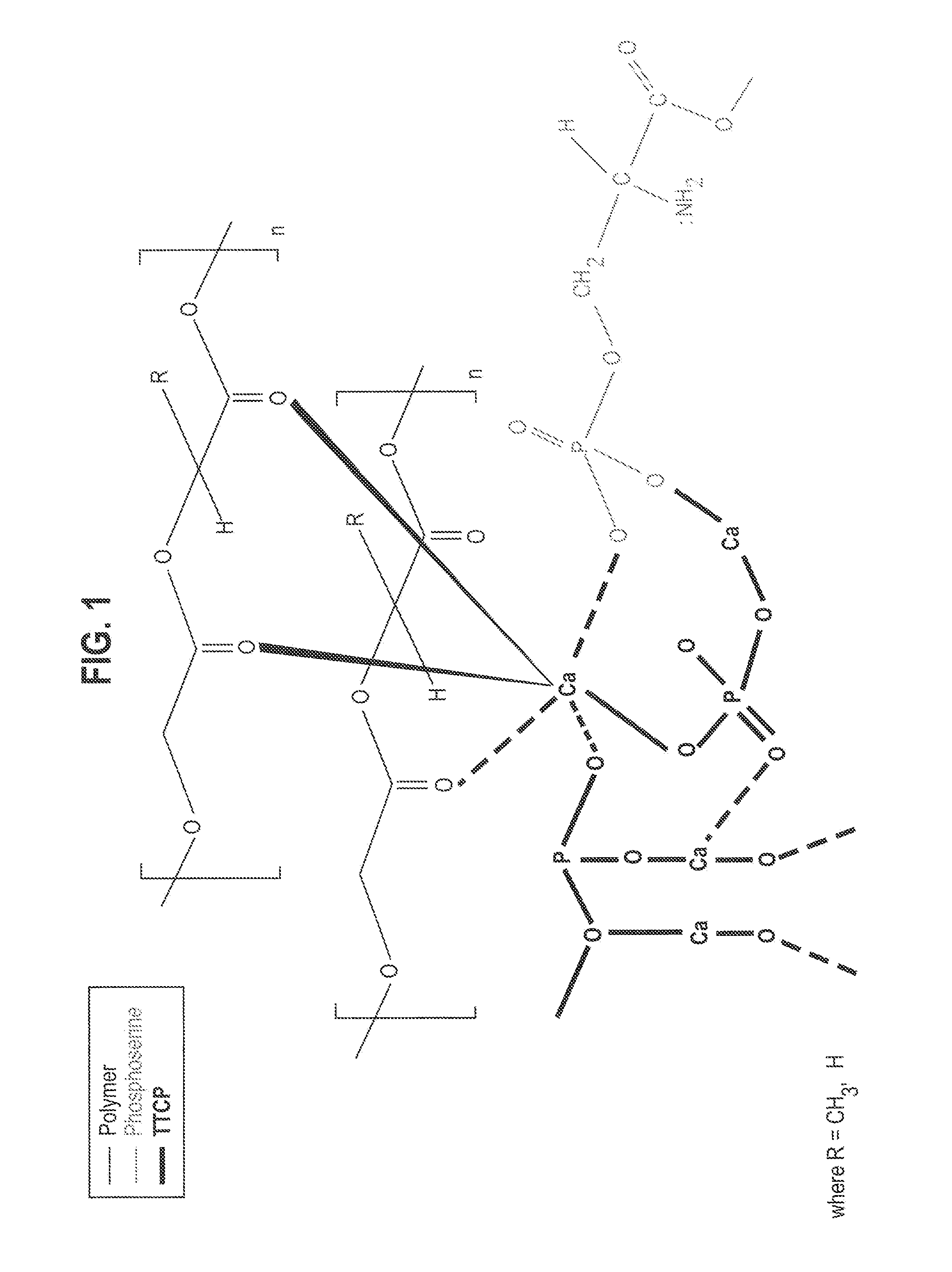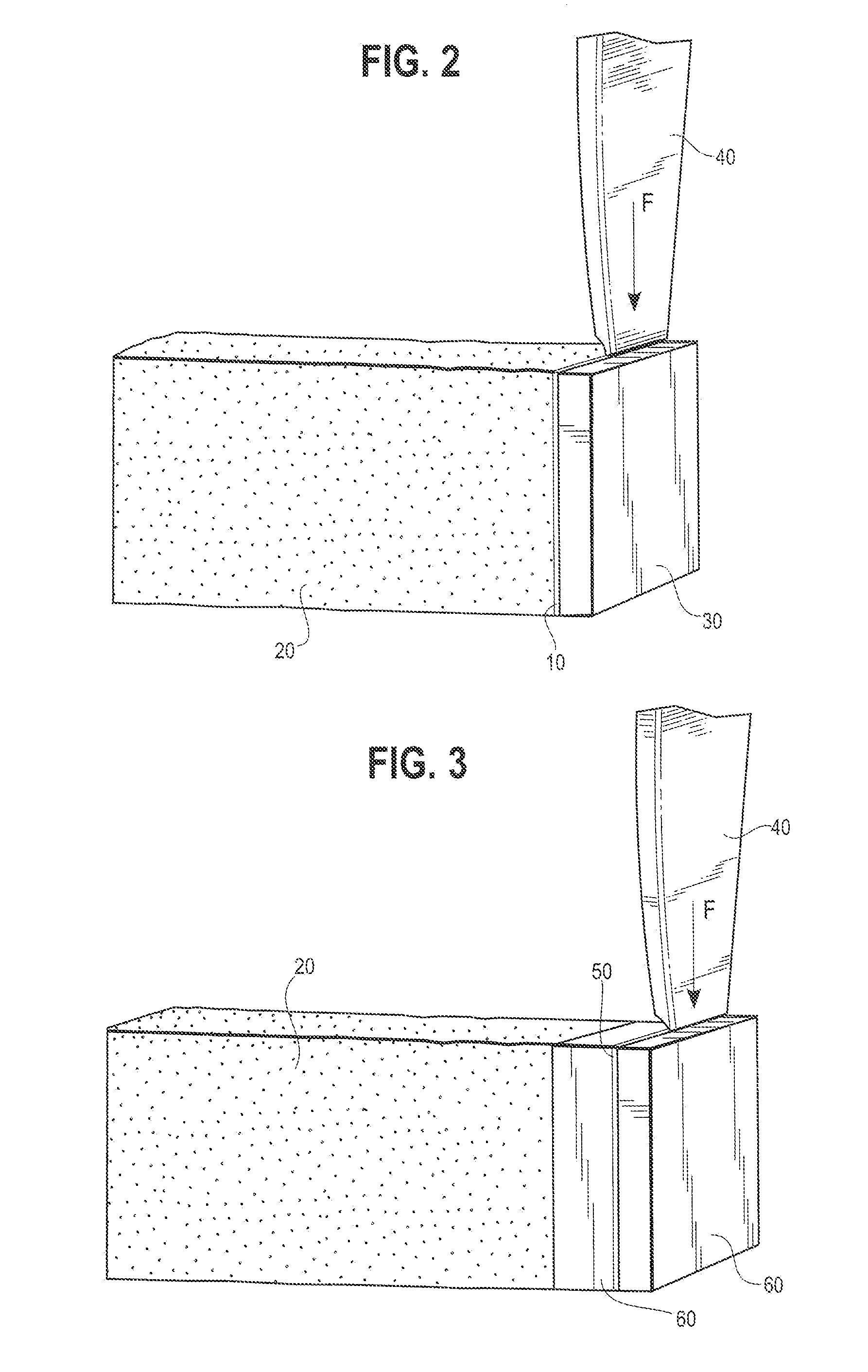Organophosphorous, multivalent metal compounds, and polymer adhesive interpenetrating network compositions and methods
a polymer adhesive and interpenetrating network technology, applied in the field of calcium phosphate cements, can solve the problems of insufficient chemical interaction between calcium phosphate composite and bone surface or other surface materials, lack of sufficient adhesive strength to adhere or fix bones together, and insufficient strength to be used to attach bone to bone or other materials
- Summary
- Abstract
- Description
- Claims
- Application Information
AI Technical Summary
Benefits of technology
Problems solved by technology
Method used
Image
Examples
example 1
PLGA Square Adhesion to Bovine Cortical Bone, 10 Min Cure
[0066]
Example1A1BComp. 1AComp. 1BComp. 1CComp. 1DTOM 250 (MPa)HydroSet (MPa)Norian (MPa)PLGAPLGAPLGAPLGAPLGAPLGA10 / 9050 / 5010 / 9050 / 5010 / 9050 / 500.640.350.160.120.070.050.720.380.080.080.20.010.960.430.110.120.030.030.830.470.230.080.120.050.990.340.220.040.140.010.690.420.130.030.09aver-0.810.400.160.080.110.03ageSt.0.150.050.060.040.060.02Dev.
[0067]As shown in FIG. 2, a small amount (10) of each of the above formulations was applied both to cortical bone (20) that has been clamped in place (clamps not shown for clarity) and to the appropriate PLGA sheet (30) and tested using a shear testing device (40) (blade only shown for clarity) with a force vector (F) applied directly to the cement bond (10). As seen from the data, the formulations of Examples 1A and 1B had significantly higher shear strength than the Comparative Examples 1A-D.
Example 2
[0068]A cement formulation having the following formulation: 250 mg OPLS, 400 mg TTCP, a...
example 2
PLGA Square Adhesion to PLGA Square, 10 Min Cure
[0069]
Example2A2BComp. 2AComp. 2BComp. 2CComp. 2DTOM 250 (MPa)HydroSet (MPa)Norian (MPa)PLGAPLGAPLGAPLGAPLGAPLGA10 / 9050 / 5010 / 9050 / 5010 / 9050 / 500.640.350.160.120.070.050.720.380.080.080.20.010.960.430.110.120.030.030.830.470.230.080.120.990.340.220.040.140.690.420.130.030.09aver-0.810.400.160.080.110.03ageSt.0.150.050.060.040.060.02Dev.
[0070]As shown in FIG. 2, a small amount (50) of each of the above formulations was applied both to the appropriate PLGA sheets (60) and the sheets were pressed together and tested using the same shear testing device with a force (F) applied directly to the cement bond. The one polymer sheet (6) was adhered to cortical bone (20) that has been clamped in place (clamps not shown for clarity). As seen from the data, the formulations of Examples 2A and 2B had significantly higher shear strength than the Comparative Examples 2A-2D.
example 3
[0071]In order to see the effect on the intrinsic material strength, polymer fibers were added to the compositions to form an interpenetrating network. A series of compositions set out in Table 1 were prepared and tested as follows. Each composition was mixed for 20 seconds in a polycarbonate bowl using either a polycarbonate pestle or spatula. After mixing, the composition was applied to both surfaces of bovine cortical bone cubes that had apposing faces using a spatula. The faces were created with a 90° angle for the bending tests (9×9.5 mm face). Prior to testing, the bone cubes were incubated within a phosphate buffered saline (PBS), solution bath at 30° C. and had pre-dampened surfaces during composition application. By 90 seconds from the start of mixing, the apposing faces were adhered together and aligned with minimal hand compression force for 10 seconds and were immediately transferred and submerged within a PBS solution bath held at 30° C. for the duration of 10 minutes. ...
PUM
| Property | Measurement | Unit |
|---|---|---|
| mean particle size | aaaaa | aaaaa |
| mean particle size | aaaaa | aaaaa |
| mean particle size | aaaaa | aaaaa |
Abstract
Description
Claims
Application Information
 Login to View More
Login to View More - R&D
- Intellectual Property
- Life Sciences
- Materials
- Tech Scout
- Unparalleled Data Quality
- Higher Quality Content
- 60% Fewer Hallucinations
Browse by: Latest US Patents, China's latest patents, Technical Efficacy Thesaurus, Application Domain, Technology Topic, Popular Technical Reports.
© 2025 PatSnap. All rights reserved.Legal|Privacy policy|Modern Slavery Act Transparency Statement|Sitemap|About US| Contact US: help@patsnap.com



